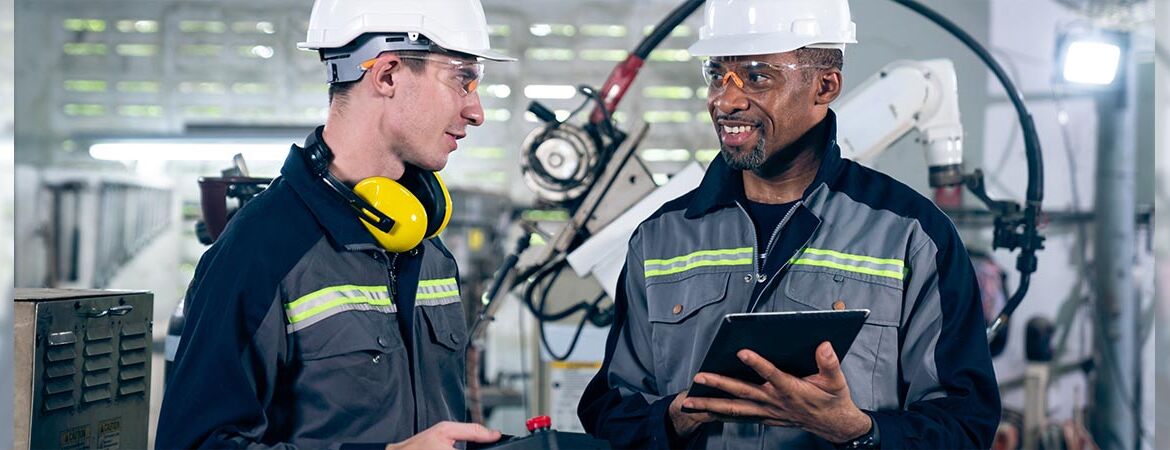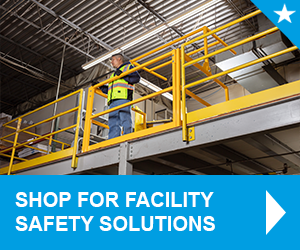
Industrial safety depends on robust site-wide fall protection, and it’s no exaggeration to say OSHA fall protection is the most critical factor for industrial facility safety. In fact, it’s only becoming more so over time.
That’s because falls are the leading cause of serious workplace injuries and the most frequently cited compliance violation. To stay ahead of their most pressing safety needs, safety managers must work full-time to protect workers throughout the facility. Fall protection is a constant concern and applies to all:
- Rooftops
- Stairs
- Ladders
- Catwalks
- Mezzanines
- Ground levels
- Loading docks
- Storage areas
At the beginning of 2024, there was an equally comprehensive increase in OSHA fines. Just as your facility’s revenue goals depend on factoring in rising overhead and supply costs, keeping compliance violations to a minimum is essential to protect workers and your bottom line.
Combined Workplace Hazards
It’s not always as simple as heeding your duty to have fall protection, even in full. Though preventing falls and falling objects should be the top priority for facility safety managers, owners, and workforces alike, it isn’t the only safety concern. In any fall protection scenario, there may also be combined workplace risks, including but not limited to:
- Confined spaces
- Dangerous machinery
- Hazardous atmospheres/substances
- Fire and explosion risks
- Powered industrial vehicles
Industrial safety also often depends on access control solutions, such as for lifting or hoisting operations, unauthorized personnel, and industrial vehicle zones. Fortunately, it’s possible to mitigate numerous overlapping safety hazards while preventing the #1 cause of injuries and fines.
The solution? Making the most strategic safety equipment investments and increasing a company culture of safety.
How Equipment Choice Affects Regulatory Compliance
The first line of defense for industrial fall protection requires a two-pronged approach:
- Proper training and communication protocols for a facility’s most relevant workplace hazards
- Effective, user-friendly, and adaptable safety equipment
Taking any action to enhance your industrial safety depends on following the right regulations for your workplace activities. Never neglect the need for routine research into your OSHA, state, or CCOHS safety regulations where your facility operates.
Also beware any manufacturer claims that their products are “OSHA approved,” because OSHA only sets out compliance standards. It’s up to the facility’s managers and their manufacturing partners to verify a given safety device meets or exceeds the intended compliance requirements (and all the better if it meets many multiple requirements).
Broad, Far-Reaching Safety Functions with Integrated and Adaptable Metal Swing Gates
The right metal swing gate can help meet an extremely wide range of the safety considerations just discussed, and more. For starters:
- Upper access points for fixed ladderways (per OSHA 1910.28[b][3][iv]), where safety gates must integrate evenly with a surrounding guardrail and toeboard system.
- Mobile ladder stands, where a metal swing gate and integrated handrails are required for all but “special-use applications” (see OSHA 1910.23[e][1][v]). While a chain or other non-rigid member may be acceptable, a self-closing gate is usually the superior choice.
- Rooftop hatches, where although 1910.28(b)(3)(v)(A) permits a single exposed side of a fixed guardrail system, an extended coverage gate maintains a complete perimeter, plus better alignment with surrounding hand grips, supporting safer ingress/egress.
Near-Constant Falling Object Protection
We mentioned the requirement for toeboards around upper fixed ladder holes, which prevents falling object hazards. To be clear, OSHA allows an exposed side where the ladder opens onto the platform, where a fixed toeboard presents a tripping hazard.
Consider, however, that you can just as easily install a full coverage gate or other mezzanine fall protection gate and prevent falling objects around the entire ladderway when closed. These are the types of measures that prove to safety inspectors that you not only take compliance seriously but surpass your basic duties.
Better Integration for Safe Access
Modular railing and safety gates meet the lion’s share of fall safety requirements, and in the most adaptable way. This is essential when a given safety challenge requires multiple devices or workflow requirements. For example:
- When a portion of railing must be opened to facilitate hoisting, a gate doesn’t replace the need for a personal fall arrest system when an employee must “lean through or over the edge” (per OSHA 1910.28[b][2][ii]). Here, a full-stop automatic swing gate helps retain focus on the task, not the equipment.
- OSHA 1910.212(a)(1) lists “barrier guards” as the first example of suitable machine guarding methods. OSHA 1910.212(a)(2) further states: “The guard shall be such that it does not offer an accident hazard in itself.” A self-closing metal swing gate fulfills the dual need for equipment access and machine guarding, where continuous railing would restrict a service technician’s movement.
These examples bring up an important point for all fall protection measures: the user-friendliness of a fall protection device is not just a matter of convenience. More streamlined industrial safety equipment of all kinds keep staff from becoming distracting at the critical moment.
How a Mezzanine Fall Protection Gate Protects Workers Above and Below
Mezzanines present unique OSHA fall protection challenges, where both machinery and manual labor are often required for extremely heavy items. It also requires simultaneously protecting workers on the platform and at ground level, who are usually vertically aligned.
The best safety solutions are by design. Yet as mentioned, fall safety also depends on proper procedure. A dual, automatic mezzanine fall protection gate covers both capacities by maintaining a barrier between upper-level staff and the leading edge at all times – even while receiving the payload.
It’s possible thanks to an open-close mechanism that operates both gates, automatically closing one as the other opens. This process reverses when workers below must receive a palette, but only after the worker above has safely moved the load into position and removed themselves from harm’s way.
Maximum Compliance with Minimal Investment
However extensive these OSHA fall protection scenarios are, they’re only a handful of common industrial safety challenges. At the same time, modular guardrails with integrated self-closing gates can meet an astonishing range of even the most complex compliance requirements.
Fabenco, a member of the Tractel family, is continually advancing metal swing gate and mezzanine fall protection gate technology. Our goal is your own: preventing safety violations with modular, custom fall protection equipment that complies with, and often surpasses, the most stringent regulatory standards.
Contact us today and our dedicated fall protection experts will help you craft a plan for addressing the safety needs at your facility.





